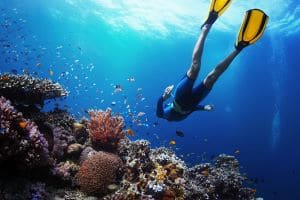Home › Best Dive Sites › Asia › India › Andaman › Havelock Island › Pilot Reef
Scuba Diving at Pilot Reef Havelock Island
The rock and coral outcrops clustered together at Pilot Reef make it a popular destination for learners and qualified divers who are interested in conservation specialty courses.
This guide explains how to get to the dive site, average depth limits, and what marine life creatures seek shelter in the reefs and sandy seabed that surrounds them.
The Best Months to Dive around Pilot Reef
One reason visitors go scuba diving at Havelock Island is for the warm sea temperatures of 26 to 30° Celsius (78-86 Fahrenheit).
This region usually gets the wet season from June to October and the dry season starts in November until May.
Even so, some dive centres in Andaman offer year round scuba diving and snorkeling lessons at the nearby islands.
This area is a paradise for scuba divers and there are many dive spots to choose from. In general, you should base the destination on which particular sea life plants and animals you are hoping to encounter.
Note: Pilot Reef dive site is a shallow location and the average depths are around twelve (12) metres. Thus, many of the local dive shops conduct the PADI® Open Water course for beginners close to this sandy region.
In general, you should expect to have good underwater visibility. In fact, the water clarity extends to forty metres (130 feet) during the optimum months for diving.
So, when is the best time to dive in the Andaman Islands? The peak season for scuba diving starts around the end of October and runs all the way through to May.
Having a tropical climate means the sea temperature is warm for most of the year, averaging 28° Celsius (around 82° Fahrenheit). But, some Andaman Island dive sites can have strong water currents, including the downwelling current where they collide with steep walls.
Note: The climate during the first half of the year is mostly sunny and hot, with flat calm seas. So, it may be best to avoid the area when the May monsoons arrive - even though diving is still available at some selected sites.
Diverse Marine Life at Pilot Reef
If you join one of the boat diving activities, and travel around six (6) kilometres to the northeast of Havelock, you will find a cluster of coral and rocky outcrops.
This 'cleaning station' is popular for a variety of fish families. It also has patches of soft white sand surrounding the flat coral reefs (ideal for beginners) located near to the entrance of the shipping channel.
Unlike many Havelock dive sites, this spot caters for learners as well as those with some experience. For example, some of the popular specialist scuba courses taught at this location include:
- Aware Shark Conservation Diver
- Coral Reef Conservation Diver
- Fish Identification Specialist
- PADI® Underwater Navigator
- Search and Recovery Diver
The shallower part of Pilot Reef dive site bottoms out around ten (10) metres. This is where you can find small reef fishes, such as bannerfish, different species of butterfly fish, and garden eels peeping out of the sand.
If you dive deeper, down to the maximum depth at twenty two (22) metres, you may get lucky and catch sightings of zebra sharks (young leopard sharks) resting on the sand banks. You may also see an occasional marbled electric ray passing overhead.
This area is also blessed with a scattering of brain corals, branching staghorn stony corals (Anthozoa), table coral, whip corals, and gorgonians.
Some common aquatic animals that scuba divers and snorkelers can see around the shallow coral reef formations include:
- Angelfish (Pomacanthidae)
- Coral reef snakes
 Damselfish (Pomacentridae)
Damselfish (Pomacentridae)- Crustaceans
- Jewel fairy basslets
- Moray eels
- Orange-spine unicornfish (Naso lituratus)
- Scorpion fish
- Sea anemones (Actiniaria)
- Slingjaw wrasse
- Trumpet fish
Pro Tip: Check out our A to Z list of marine vertebrate sea animals for more interesting facts about different fish species.
Related Information and Help Guides
- Dixon's Pinnacles Dive Site at Havelock Island
- Inchkeith Wreck Dive Site Andaman Islands
- Scuba Diving and Snorkeling at Nemo Reef Havelock
Note: The main section contains a list of Havelock Island dive sites for divers and snorkelers with detailed information about the marine species that inhabit this area of Ritchie's Archipelago.